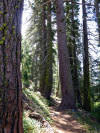



















Graeagle - September '23
walk one - Grass Lake
return to mdimage index
On Friday morning we went to the almost next-door Graeagle Restaurant for breakfast, and local peaches were in season & delicious.
The drive to the trailhead took about 20 minutes.
The trail to Grass Lake begins where Jamison City was first settled in 1853, as a tent city, shortly after gold was struck on nearby Eureka Peak. Today, few mine buildings remain.
The first half of the walk was steep, with a mostly rocky surface. It leveled out and was not rocky as we approached the lake and then walked past it for a short exploration and to find a scenic spot to have lunch.
The trail continues further uphill to 3 or 4 more lakes, and we saw backpackers heading that way. As the sign shows, you can connect with the PCT.
note - you can enlarge any part of a picture by left-clicking in and then out again (with some exceptions).
note - The photos show some haze, smoke-like, which fortunately was not there on the 2nd & 3rd hikes.
The Grass Lake trail was an out & back walk of 4+ miles, with 600 ft. of gain.
The Plumas-Eureka State Park visitor center, at Johnsville, was a short drive from the trailhead. We had a brief visit to the museum & the partially restored stamp mill.
We were the only ones there and the lone Ranger told us to not to ask her any historical questions, because she just arrived, from a Park in New Hampshire.
The Museum is in the old mine bunkhouse, painted red with white trim.
 |
park museum |
 |
 |
simplified model of stamp mill | |
 |
 |
Mohawk Stamp Mill |
 |
In 1876, Johnsville became the main mining City in the Graeagle area, with refined homes, instead of tents.
The Mohawk Stamp Mill operated until 1890 and extracted $8 Million in gold from local mines, including Jameson, equivalent to $270M today. By the time all mines were closed (in 1904) the miners had excavated 65 miles of underground tunnels in the immediate area.
On our arrival night at Graeagle Meadows (the day before) we had a potluck dinner at the cabin I shared with John & Kathy, Jean coming from her cabin, a short drive away.
On the second night, after the hike, it was difficult getting a dinner reservation, because the town's most popular restaurant, Gumpa's, burned to the ground one week before. There used to be three good restaurants here, now suddenly down to two.
We were fortunate to get a table at 7:15 pm at the Grizzly Grille, in Blairsden, a few minutes' drive north on 89. Two doors down were the charcoal-looking remains of Gumpa's, an old wood structure which must have burned up fast ! We were glad to hear that no one was injured.
At dinner we discussed how losing a restaurant in such a small town had to be a terrible blow to local workers and families & the economy in general, and, also impacts downstream suppliers in Truckee, Reno, and beyond.
That Gumpas was a magnet for community cohesiveness goes w/o saying. The women who served us said they were all still in shock.
note - only a few months later, on a walk at Cronan Ranch, Dave P. was shocked to hear of this and said he & and his wife went to Graeagle every fall and Gumpas was their favorite dining place.
go to next day's hike - Bear Lakes and Round Lake
return to mdimage index
Postscript - Unexpected History dept.
The Plumas-Eureka State Park brochure states that "in the winter, heavy snows inspired miners to organize downhill ski races, on open terrain (where the trees near the mines had been removed). They used two 12 ft. long 'Norwegian style' long-boards, some weighing up to 20 lbs. Skiers had one large ski pole to carry between the legs as a brake."
Racers went straight down the fall line, and the fastest skiers were officially clocked at 60 mph. The initial "downhill ski race" held in winter 1861 is now internationally acknowledged as the first recorded downhill ski competition in the western hemisphere.
Some historians speculate that the mine tramways may have been used as the world's first ski lifts.
go to next day's hike - Bear Lakes and Round Lake